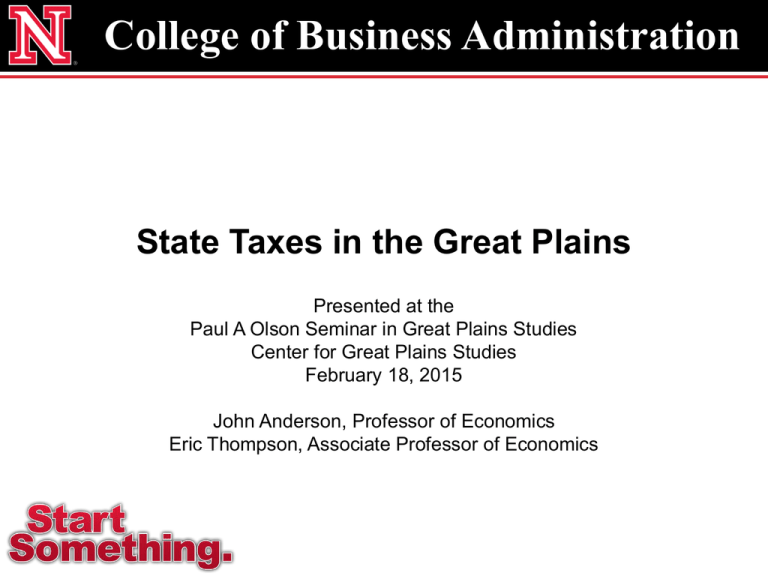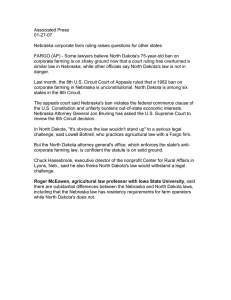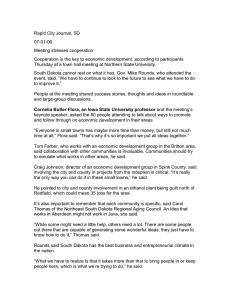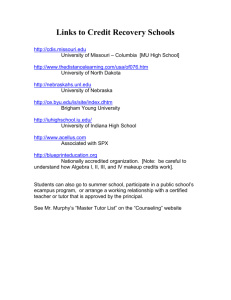College of Business Administration State Taxes in the Great Plains
advertisement

College of Business Administration State Taxes in the Great Plains Presented at the Paul A Olson Seminar in Great Plains Studies Center for Great Plains Studies February 18, 2015 John Anderson, Professor of Economics Eric Thompson, Associate Professor of Economics College of Business Administration Outline • Part 1: Overview of State Revenue Sources and Expenditure Trends • Part 2: Nebraska Tax Reform Issues • Part 3: Property Taxes • Part 4: Issues in Other States College of Business Administration 2.50 2.00 1.50 1.00 0.50 0.00 Colorado Iowa Kansas Nebraska South Dakota Wyoming 2012 Expenditures Relative to 2002 Expenditures, by State North Dakota Texas College of Business Administration Colorado Corporate income 2% All other taxes 4% Individual income 23% Property 34% Sales and gross receipts 37% Colorado Own-Source Revenue, 2012 College of Business Administration Iowa Corporate income All 3% other taxes 3% Individual income 24% Property 35% Sales and gross receipts 35% Iowa Own-Source Revenue, 2012 College of Business Administration Kansas Corporate income 3% All other taxes 3% Individual income 23% Property 32% Sales and gross receipts 39% Kansas Own-Source Revenue, 2012 College of Business Administration Nebraska Corporate income 3% All other taxes 5% Individual income 23% Property 37% Sales and gross receipts 32% Nebraska Own-Source Revenue, 2012 College of Business Administration South Dakota Corporate income 2% All other taxes Individual 8% income 0% Property 36% Sales and gross receipts 54% South Dakota Own-Source Revenue, 2012 College of Business Administration Wyoming Corporate income 0% All other taxes 29% Property 35% Sales and gross receipts 36% Individual income 0% Wyoming Own-Source Revenue, 2012 College of Business Administration North Dakota Property 12% All other taxes 51% Sales and gross receipts 27% Corporate income 3% Individual income 7% North Dakota Own-Source Revenue, 2012 College of Business Administration Corporate income 0% Individual income 0% Texas All other taxes 10% Property 42% Sales and gross receipts 48% Texas Own-Source Revenue, 2012 College of Business Administration Part 2: Tax Reform College of Business Administration Tax Reform • Four Principles of Tax Reform – 1) reduce sales tax exemptions for household goods and services, – 2) reduce taxes most for the most mobile productive resources, – 3) tax consumption more and production less, and – 4) levy taxes at the level of government that provides productive public services. College of Business Administration Tax Reform • Reduce marginal income tax rates. Principles 2) and 3) • Broaden the sales tax base on consumer goods and services. Principle 1) • Eliminate the Real Property Tax Credit. Principle 2) and 4) College of Business Administration Tax Reform • There are only a handful of consumer sales tax exemptions that could bring substantial revenue – Food (unprepared) – Prescription medicine – Gasoline – Health care services – Tuition paid to post-secondary institutions College of Business Administration Example 1 • Cut and Simplify Income Tax Rates – 2 Personal Income Rates: 2.5% and 5.5% (-$402M) – Corporate Income Tax Rates: 3.0% and 5.5% (-$57M) • Broaden the Sales Tax Base – Sales Taxes on Personal Services and Repair Labor (+$89M) – Sales tax on food (unprepared) (+$129M) – Sales tax on prescription medicine and medical equipment (+$125M) • Eliminate the Real Property Tax Credit (+$115M) College of Business Administration Example 2 • Cut Income Tax Rates – Personal Income Rates: 2.5%, 3.0%, 3.5% and 5.5% ($283M) – Corporate Income Tax Rates: 3.0% and 5.5% (-$57M) • Broaden the Sales Tax Base – Sales Taxes on Personal Services and Repair Labor (+$89M) – Sales tax on food (unprepared) (+$129M) • Eliminate the Real Property Tax Credit (+$115M) College of Business Administration Nebraska Also Has Tax Cuts • “The Nebraska Budget Cycle” • In recent decades in Nebraska, – We cut spending during economic recessions to balance the budget – We cut taxes during economic expansions as budget surpluses grow College of Business Administration Kansas 2012 Tax Law • Tax “Reform” Not Revenue Neutral and without Spending Cuts • 2012 Tax Cut – Cut tax rates and deductions without broadening the tax base – 2 income tax rates (3% and 4.9%) – Eliminated tax on pass through entities – proprietorships, partnership, LLCS and Scorporations College of Business Administration Kansas 2012 Tax Law • $800 million annual reduction in revenue – tax cuts generally will not fully fund themselves • Kansas had no plan on spending cuts, or priorities about what to cut • Cuts addressed later. According to the Center on Budget and Policy Priorities – Cuts in per pupil school aid • 15% to 20% below pre-recession levels – Other cuts: higher education, health College of Business Administration Kansas 2013 Revision • Further reduction (over time) in income tax rates - 2.3% and 3.9% • Income tax base broadening introduced – steadily reduced value of deductions • Canceled most of a planned reduction in the state sales tax rate • Restored $300 million in year 1 and $200 million in year 2; but ultimately revenue neutral College of Business Administration Colorado • Taxes include: – 2.9% retail and medical marijuana sales tax – 10% retail marijuana special sales tax – 15% marijuana excise tax – Retail and medical marijuana application and license fees • FY 2014-15 Total marijuana taxes, licenses and fees $52.6 million • May require rebate under TABOR College of Business Administration Part 3: Property Taxes College of Business Administration College of Business Administration College of Business Administration College of Business Administration College of Business Administration North Dakota • North Dakota early on worked to develop a revenue portfolio which was not dependent on oil revenue • However, ultimately the state has become fairly dependent College of Business Administration North Dakota • The original proposal was to place all oil and gas revenue above $100 million per year in a Legacy Fund • The compromise was to earmark 30% of oil extraction and production taxes go to LEGACY FUND • Fund can be spent after 2017, with permission of super-majority of the state legislature College of Business Administration North Dakota • With just 30% going to the LEGACY FUND, – a 50% reduction in oil prices means a 35% reduction in annual oil tax revenue to the general fund • The state, however, also has run large budget surpluses, stored in a rainy day fund College of Business Administration Property Tax Policy Ideas • Nebraska’s property tax system with assessments based on market value is exemplary. – This provides for a fair and efficient tax system and should not be changed. • Nebraska’s property tax system is classified – Agricultural property is assessed at 75% of market value – Other property is assessed at 100% of market value, including residential, commercial, and industrial property – Any reduction in the agricultural assessment ratio will shift the property tax burden to other property owners College of Business Administration Property Tax Policy Ideas • If a new state mechanism for property tax relief is desired, the state should consider consolidating its current $66 million expenditure for the Homestead Exemption program and its $140 million expenditure for general property tax relief into a new circuit breaker program that provides targeted tax relief. – Tax relief would be provided to any taxpayer whose property tax bill is high relative to the income of the taxpayer (measured broadly). – Tax relief could be delivered in the form of a refundable credit on the state income tax. College of Business Administration Property Tax Policy Ideas • If experimentation in property tax reform is desired, a state program should be considered that permits local communities to implement a graded tax system, with land tax rate higher than the improvements tax rate (or a land value tax with zero tax on improvements) on a pilot program basis. College of Business Administration Thank You Any Questions?




